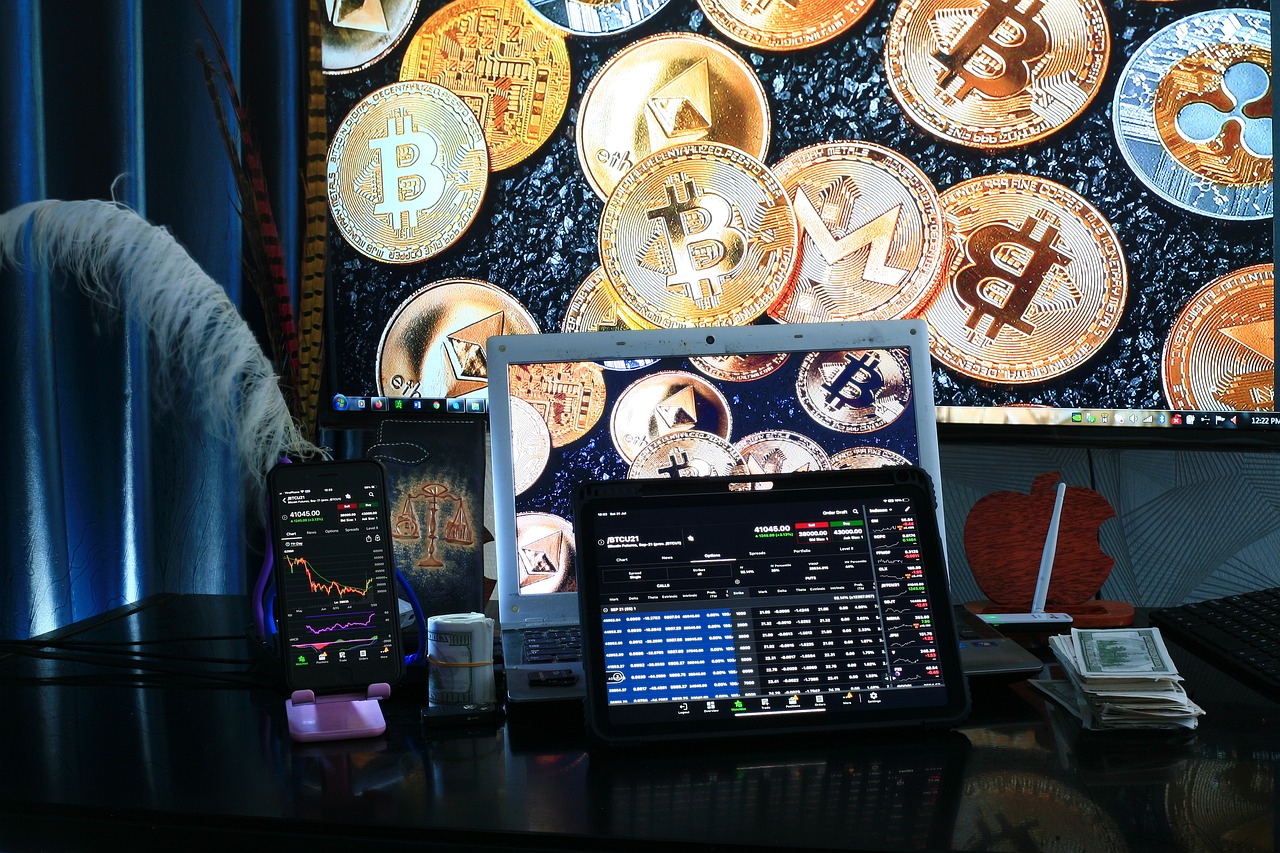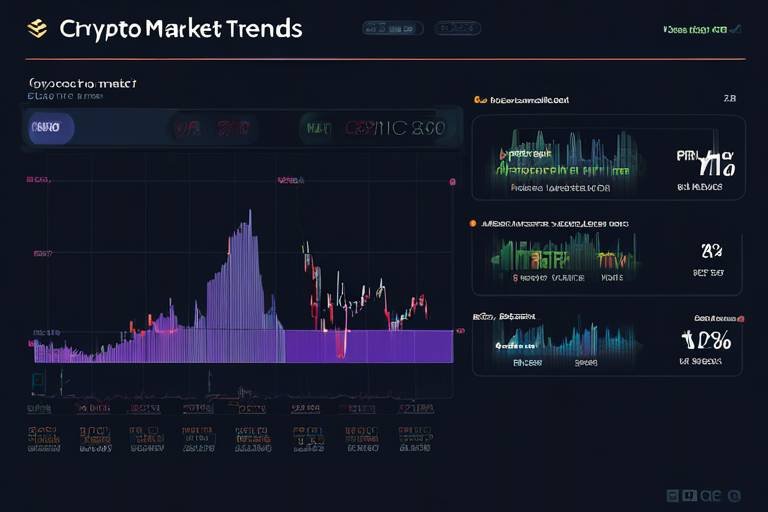Understanding Volatility in Cryptocurrency Markets
Volatility in cryptocurrency markets is a term that often sends shivers down the spine of both novice and seasoned investors. But what does it really mean? In simple terms, volatility refers to the degree of variation in trading prices over time. It's like riding a roller coaster—one minute you're at the top, feeling on top of the world, and the next, you're plummeting down, heart racing and palms sweating. This unpredictability is what makes the crypto market both thrilling and terrifying. Understanding how these rapid price changes can impact investment strategies and market behavior is crucial for anyone looking to navigate this digital landscape successfully.
Imagine waking up one morning to find that your favorite cryptocurrency has skyrocketed in value overnight. Exciting, right? But then, just as quickly, it plunges back down. This is the nature of volatility in the crypto world. Unlike traditional markets, where prices tend to move more steadily, cryptocurrencies can experience dramatic shifts in value in a matter of hours or even minutes. This rapid fluctuation can lead to significant gains for some, while others may face devastating losses. Therefore, grasping the concept of volatility is not just beneficial; it's essential for anyone looking to invest in cryptocurrencies.
As we delve deeper into this topic, we will explore the various causes of volatility, its impacts on investors, and the tools available to analyze these fluctuations. By understanding the underlying factors contributing to price changes, investors can better anticipate market movements and make informed decisions. So, buckle up as we navigate through the ups and downs of cryptocurrency volatility!
Volatility is not just a buzzword; it's a fundamental aspect of the cryptocurrency market that every investor should be aware of. It refers to the degree of variation in trading prices over time. In the realm of cryptocurrencies, this can manifest as rapid price changes that can occur within short time frames. For instance, a cryptocurrency could experience a 20% increase in value one day and then drop by 15% the next. These fluctuations can be attributed to various factors, including market sentiment, regulatory news, and technological advancements.
Understanding volatility is crucial for developing effective trading strategies. Investors must recognize that the same factors that drive prices up can just as easily push them down. This duality is what makes the market both risky and rewarding. It’s essential to approach cryptocurrency trading with a clear understanding of how volatility works, as it can significantly impact investment outcomes.
Several factors contribute to the volatility seen in cryptocurrency markets, and understanding these can help investors anticipate price movements. Here are some of the primary causes:
- Market Sentiment: The emotions of investors play a significant role in driving volatility. Fear and greed can lead to rapid price changes, making it essential to monitor market psychology.
- Regulatory News: Announcements regarding regulations can have a profound impact on cryptocurrency prices. Investors need to stay informed about the legal landscape to navigate these fluctuations effectively.
- Technological Advancements: Innovations in blockchain technology and decentralized finance (DeFi) can influence market dynamics, leading to increased volatility.
- Macroeconomic Trends: Global economic conditions, such as inflation rates and geopolitical events, can also affect investor behavior and market stability.
Volatility can present both risks and opportunities for investors. On one hand, it can lead to significant losses if not managed properly; on the other hand, it can create opportunities for savvy traders. Recognizing these impacts is essential for developing effective trading strategies and managing investment portfolios.
For instance, during volatile periods, implementing risk management strategies becomes vital. Techniques such as diversification—spreading investments across various assets—and setting stop-loss orders can help mitigate potential losses. Conversely, opportunistic trading can also arise from volatility. Experienced traders who understand market patterns and timing can capitalize on price swings, leading to profitable trades. However, this requires careful analysis and quick decision-making.
What is the Fear and Greed Index?
The Fear and Greed Index is a tool used to gauge market sentiment by analyzing various factors, including volatility, market momentum, and social media activity. It helps investors understand whether the market is driven by fear or greed.
How can I protect my investments during volatile periods?
Implementing risk management strategies, such as diversification and stop-loss orders, can help protect your investments. Additionally, staying informed about market trends and news can aid in making timely decisions.
Are there tools available to analyze cryptocurrency volatility?
Yes, various tools and indicators, such as Bollinger Bands and the Volatility Index (VIX), can help analyze market volatility and assist in making informed trading decisions.

What is Volatility?
Volatility is a term that often sends shivers down the spine of investors, but what does it really mean? In the simplest terms, volatility refers to the degree of variation in trading prices over time. Imagine you're on a roller coaster; the ups and downs are exhilarating but can also be terrifying. Similarly, in the cryptocurrency market, prices can swing dramatically within short periods, leading to both thrilling opportunities and daunting risks.
Understanding volatility is crucial for anyone looking to navigate the choppy waters of cryptocurrency investments. Unlike traditional assets like stocks or bonds, cryptocurrencies are known for their extreme price fluctuations. For instance, Bitcoin, the most popular cryptocurrency, has experienced price changes of over 10% in a single day. This level of unpredictability can make or break an investment strategy.
To grasp the concept of volatility better, consider these key aspects:
- Price Fluctuations: The constant rise and fall of prices can lead to potential profit but also significant losses.
- Market Reaction: Volatility often triggers emotional responses from investors, leading to panic selling or exuberant buying.
- Investment Strategies: Understanding volatility helps in developing strategies that can capitalize on price movements while mitigating risks.
In essence, volatility is not just a number; it's a reflection of market sentiment, investor behavior, and external factors influencing the cryptocurrency landscape. By keeping an eye on volatility, investors can make informed decisions, whether they're looking to enter the market or exit during turbulent times.
As we delve deeper into the world of cryptocurrency, it becomes increasingly clear that recognizing and understanding volatility is fundamental. It’s the heartbeat of the market, dictating how investors react, strategize, and ultimately succeed or fail in their endeavors.

Causes of Cryptocurrency Volatility
Cryptocurrency markets are notorious for their unpredictable price swings, and understanding the causes of this volatility is essential for any investor looking to navigate these turbulent waters. Several factors contribute to the fluctuations in cryptocurrency prices, and they can often intertwine to create a perfect storm of market activity. One of the primary drivers is market sentiment, which encompasses the collective emotions and attitudes of investors. When optimism reigns, prices can skyrocket, but when fear takes hold, the market can plummet just as quickly. This emotional rollercoaster is further amplified by the rapid dissemination of information, especially through social media platforms, where news can spread like wildfire, influencing investor behavior almost instantaneously.
Another significant cause of volatility is regulatory factors. Governments around the world are still grappling with how to handle cryptocurrencies, and any announcement regarding regulations can lead to immediate and drastic price changes. For instance, news of a country banning cryptocurrency trading or imposing heavy taxes can trigger panic selling, while more favorable regulations can lead to price surges. Investors must stay alert to these developments, as they can have a profound impact on market dynamics.
Technological advancements also play a crucial role in the volatility of cryptocurrencies. Innovations such as blockchain scalability and the rise of decentralized finance (DeFi) platforms can create new opportunities but also introduce uncertainties. As new technologies are developed and adopted, they can disrupt existing market structures, leading to unpredictable price movements. For instance, a major upgrade to a cryptocurrency's underlying technology might excite investors, leading to a surge in price, while any technical hiccups could result in swift declines.
Additionally, broader macroeconomic trends can influence cryptocurrency markets. Factors such as inflation rates, interest rates, and global economic stability can affect investor confidence and the flow of capital into cryptocurrencies. For example, in times of economic uncertainty, some investors might flock to cryptocurrencies as a hedge against traditional financial markets, causing prices to rise. Conversely, a stable economic environment might lead investors to seek out more traditional assets, potentially resulting in a drop in cryptocurrency prices.
To summarize, the causes of cryptocurrency volatility are multifaceted and include:
- Market Sentiment: Driven by emotions such as fear and greed.
- Regulatory Factors: Government actions and announcements.
- Technological Advancements: Innovations that can disrupt markets.
- Macroeconomic Trends: Economic indicators that influence investment behavior.
Understanding these causes can empower investors to make informed decisions and anticipate potential market movements, allowing them to navigate the often tumultuous waters of cryptocurrency trading with greater confidence.
- What is the main cause of volatility in cryptocurrency? Market sentiment, regulatory news, and technological advancements are key factors that contribute to volatility.
- How can I protect my investments from volatility? Implementing risk management strategies like diversification and stop-loss orders can help mitigate potential losses.
- Does social media influence cryptocurrency prices? Yes, social media can amplify market sentiment and lead to rapid price changes.
- Are there tools to analyze cryptocurrency volatility? Yes, tools like technical analysis indicators and the Volatility Index (VIX) can assist in analyzing market conditions.

Market Sentiment
Market sentiment is a powerful force in the world of cryptocurrency, often acting as the invisible hand that drives prices up or down. It's fascinating how the collective emotions of investors can lead to significant market movements, sometimes more than the fundamentals of a cryptocurrency itself. Imagine a group of friends deciding whether to go to a concert or stay home; if one person is excited, it might sway the others to join in on the fun. Similarly, in the crypto markets, fear and greed can create a domino effect, causing prices to fluctuate wildly.
When investors are feeling optimistic, they tend to buy more, pushing prices higher. Conversely, when fear takes over—often due to bad news or market crashes—panic selling can ensue, leading to sharp declines. This emotional rollercoaster is what makes cryptocurrency so thrilling yet risky. To navigate this unpredictable landscape, it's essential for investors to keep a close eye on market sentiment indicators.
One of the most popular tools for gauging market sentiment is the Fear and Greed Index. This index provides a snapshot of the emotional state of the market, ranging from extreme fear to extreme greed. By understanding where the market stands on this spectrum, investors can make more informed decisions about when to buy or sell. For instance, if the index indicates extreme fear, it might be a good time to buy, as prices could be undervalued. On the other hand, if the market shows extreme greed, it might signal a bubble, prompting a sell-off.
Furthermore, the influence of social media cannot be underestimated. Platforms like Twitter and Reddit have become hotspots for cryptocurrency discussions, where news can spread like wildfire. A single tweet from a high-profile influencer can send prices soaring or crashing within minutes. Therefore, staying updated with trending topics and discussions on social media can provide valuable insights into market sentiment. It's like having a radar that detects shifts in the emotional landscape of investors.
In conclusion, understanding market sentiment is crucial for anyone looking to invest in cryptocurrencies. By keeping an eye on emotional indicators like the Fear and Greed Index and being aware of social media trends, investors can better position themselves to navigate the volatile waters of the crypto market.
- What is the Fear and Greed Index?
This index measures market sentiment by analyzing various factors such as volatility, market momentum, and social media trends to determine whether investors are feeling fearful or greedy. - How can social media impact cryptocurrency prices?
Social media can amplify market sentiment, causing rapid price changes based on news, trends, or influencer opinions that spread quickly through these platforms. - Why is understanding market sentiment important?
Understanding market sentiment helps investors anticipate price movements and make informed decisions about when to buy or sell their assets.

Fear and Greed Index
The is an essential tool for cryptocurrency investors looking to navigate the tumultuous waters of market volatility. Imagine trying to sail a ship through stormy seas without a compass; that's what trading without understanding market sentiment feels like. This index quantifies the emotions driving the market, categorizing them into two primary states: fear and greed. Essentially, it provides a snapshot of how investors are feeling at any given moment, which can significantly influence price movements.
When the index indicates high levels of fear, it often suggests that investors are worried about potential losses, leading to panic selling. Conversely, when greed dominates the sentiment, it can result in overzealous buying, pushing prices up rapidly. Understanding where the market lies on this spectrum can help you make informed decisions about when to buy or sell. For instance, if the index shows extreme fear, it might indicate a buying opportunity as prices could be undervalued. On the flip side, extreme greed may signal a potential market correction on the horizon.
To illustrate the workings of the Fear and Greed Index, let's look at a simplified table that describes the different ranges of the index and their implications:
| Index Range | Market Sentiment | Implications |
|---|---|---|
| 0-24 | Extreme Fear | Potential buying opportunity; prices may be undervalued. |
| 25-49 | Fear | Market cautious; consider monitoring for signs of recovery. |
| 50-74 | Greed | Market optimism; prices may be overvalued, consider selling. |
| 75-100 | Extreme Greed | High risk of market correction; prudent to take profits. |
By keeping an eye on the Fear and Greed Index, you can better align your trading strategies with the prevailing market conditions. It's like having a weather forecast for your investments—knowing when to prepare for a storm or when to enjoy the sunshine can make all the difference in your trading success. However, it's important to combine this tool with other indicators and analyses to create a more comprehensive trading strategy. After all, relying solely on one indicator can lead to misinformed decisions.
- What is the Fear and Greed Index? The Fear and Greed Index is a tool that measures market sentiment, indicating whether investors are feeling fearful or greedy.
- How can I use the Fear and Greed Index in my trading strategy? You can use the index to gauge market sentiment and make informed decisions about buying or selling cryptocurrencies based on whether the market is in a state of fear or greed.
- Where can I find the Fear and Greed Index? The Fear and Greed Index can be found on various financial news websites and cryptocurrency market analysis platforms.

Social Media Influence
In today’s digital age, the power of social media cannot be overstated, especially in the realm of cryptocurrency. Platforms like Twitter, Reddit, and Telegram have evolved into bustling hubs where news, opinions, and trends spread like wildfire. This rapid dissemination of information can lead to sudden price swings in the cryptocurrency market, often catching investors off guard. Just think about it: a single tweet from a prominent figure can send a cryptocurrency soaring or plummeting within minutes.
Moreover, the nature of social media allows for real-time reactions and discussions. Investors often flock to these platforms to gauge market sentiment and to see what others are saying about specific coins or market trends. The fear of missing out (FOMO) can drive many to make impulsive decisions based on trending hashtags or viral posts. This phenomenon illustrates how intertwined social media and cryptocurrency have become, creating a feedback loop where emotions and market movements are closely linked.
To further understand this influence, consider the following aspects:
- Viral Trends: Memes, challenges, or hashtags can gain traction and lead to increased interest in specific cryptocurrencies.
- Influencer Endorsements: When well-known personalities endorse a cryptocurrency, it can lead to a surge in interest and investment.
- Community Engagement: Active communities on platforms like Reddit can create a sense of belonging and shared purpose, often leading to coordinated buying or selling.
As social media continues to shape the landscape of cryptocurrency, investors must stay vigilant. Monitoring social media trends and engaging with community discussions can provide valuable insights. However, it’s crucial to approach this information critically. Not all buzz translates into genuine value, and the hype can sometimes overshadow fundamental analysis. In essence, while social media can be a powerful tool for understanding market sentiment, it should be used in conjunction with other analytical methods to make well-informed investment decisions.
Q1: How does social media impact cryptocurrency prices?
A1: Social media can significantly impact cryptocurrency prices by spreading news and trends quickly, leading to rapid changes in market sentiment and investor behavior.
Q2: Should I rely solely on social media for investment decisions?
A2: No, while social media can provide valuable insights, it should be used alongside other analytical tools and methods to make informed investment decisions.
Q3: What are some reliable platforms to follow for cryptocurrency news?
A3: Platforms like Twitter, Reddit, and specialized cryptocurrency news websites can provide timely updates and community insights. However, always verify information from multiple sources.
Q4: How can I identify credible influencers in the cryptocurrency space?
A4: Look for influencers with a history of accurate predictions, a strong following, and engagement with their audience. Always be cautious of those who promote coins without transparency.

Regulatory Factors
Regulatory factors are a significant driving force behind the volatility seen in cryptocurrency markets. The landscape of regulations surrounding cryptocurrencies is constantly evolving, and this can create waves of uncertainty and opportunity for investors. When governments announce new laws or guidelines, the market often reacts swiftly, leading to price fluctuations that can be both dramatic and unpredictable. For instance, a country announcing a crackdown on crypto exchanges can lead to panic selling, while positive regulatory news, such as the approval of a Bitcoin ETF, can spur a buying frenzy.
Understanding the legal framework in which cryptocurrencies operate is crucial for any investor looking to navigate this volatile environment. Here are some key aspects that can influence market behavior:
- Government Announcements: News from regulatory bodies, such as the SEC in the United States or the FCA in the UK, can have immediate effects on cryptocurrency prices. A statement about potential regulations can lead to rapid price declines.
- Tax Regulations: How cryptocurrencies are taxed can also impact investor behavior. Countries with favorable tax treatments for crypto investments may see increased participation, while harsh tax laws can deter investors.
- Legal Status: The classification of cryptocurrencies (as commodities, securities, or currencies) can greatly influence their market dynamics. For example, if a cryptocurrency is classified as a security, it may be subject to stricter regulations, affecting its trading volume and price.
Moreover, the global nature of cryptocurrency means that regulations can vary significantly from one country to another. This patchwork of regulations creates an environment where investors must stay informed about both local and international legal developments. For instance, while one country may embrace cryptocurrencies and blockchain technology, another might impose strict bans, leading to capital flight or sudden market corrections.
In conclusion, regulatory factors play a pivotal role in shaping the volatility of cryptocurrency markets. Investors who actively monitor regulatory developments and understand their implications can better position themselves to navigate the ups and downs of this exciting yet unpredictable market.
Q: How do regulations impact cryptocurrency prices?
A: Regulatory announcements can lead to immediate market reactions, causing prices to rise or fall based on investor sentiment towards the news.
Q: Are all countries regulating cryptocurrencies the same way?
A: No, regulations vary widely from country to country. Some nations have embraced cryptocurrencies, while others have imposed strict bans or regulations.
Q: How can investors stay informed about regulatory changes?
A: Investors can follow news from reliable financial news sources, subscribe to cryptocurrency newsletters, and join relevant online forums and communities to stay updated.

Impacts of Volatility on Investors
Volatility in cryptocurrency markets can be a double-edged sword for investors. On one hand, it presents significant risks, while on the other, it offers unique opportunities for profit. Understanding these impacts is crucial for anyone looking to navigate the often tumultuous waters of crypto investing. The emotional rollercoaster that comes with rapid price fluctuations can lead to hasty decisions, which is why it's essential for investors to equip themselves with knowledge and strategies.
When the market is volatile, prices can swing dramatically within short timeframes. This means that an investor's portfolio can experience substantial gains or losses almost overnight. For example, an investor who bought Bitcoin at $50,000 might see it soar to $60,000 within days, but that same investor could also watch it plummet back to $45,000 just as quickly. Such rapid changes can create a sense of urgency, prompting investors to react impulsively. This is where a solid understanding of market dynamics becomes invaluable.
Moreover, volatility can heavily influence trading psychology. During bullish trends, investors may feel euphoric and overly confident, leading to over-leveraged positions. Conversely, in bearish markets, fear can take over, causing panic selling. To manage these emotional responses, investors should consider implementing risk management strategies. Some effective techniques include:
- Diversification: Spreading investments across various cryptocurrencies can help mitigate risk. If one asset underperforms, others may balance the portfolio.
- Stop-Loss Orders: Setting predetermined exit points can protect investors from significant losses during sudden downturns.
However, it’s not all doom and gloom. For those who are willing to take calculated risks, volatility can create opportunistic trading scenarios. Traders who can analyze market trends and patterns may find that they can capitalize on price swings. This requires a keen eye for detail and a willingness to act quickly, but for the savvy investor, the rewards can be substantial. It's akin to surfing: catching the right wave at the right moment can lead to an exhilarating ride, while missing it can result in a wipeout.
Additionally, the impacts of volatility extend beyond individual investors. They can also influence market sentiment as a whole. High volatility can attract media attention, which in turn can drive more investors into the market—both seasoned and new. This influx can further exacerbate price swings, creating a cycle of volatility that can be both exciting and perilous.
In conclusion, recognizing the impacts of volatility on investors is essential for developing effective trading strategies. By understanding the risks and seizing the opportunities that arise from market fluctuations, investors can navigate the cryptocurrency landscape more effectively. As the saying goes, "Fortune favors the bold," but it also rewards the informed. Therefore, staying educated and prepared is key to thriving in this ever-changing environment.
- What is volatility in cryptocurrency? Volatility refers to the degree of variation in trading prices over time, indicating how much a cryptocurrency's price can change.
- How can I manage risks associated with volatility? Implementing strategies like diversification and stop-loss orders can help mitigate risks during volatile periods.
- Can volatility lead to profitable trading opportunities? Yes, savvy traders can capitalize on price swings during volatile periods, but it requires careful analysis and quick decision-making.
- What role does market sentiment play in volatility? Market sentiment, driven by emotions like fear and greed, can significantly influence price movements and contribute to volatility.

Risk Management Strategies
When it comes to navigating the wild world of cryptocurrency, having a solid risk management strategy is like having a life jacket on a turbulent sea. The unpredictable nature of crypto prices can leave even the most seasoned investors feeling like they're on a rollercoaster ride. To keep your portfolio afloat, it's essential to implement strategies that can help mitigate potential losses while maximizing gains. One of the most effective ways to manage risk is through diversification. By spreading your investments across a variety of cryptocurrencies, you can reduce the impact of a single asset's poor performance on your overall portfolio. Just like not putting all your eggs in one basket, diversification allows you to weather the storm when one coin takes a nosedive.
Another crucial strategy is the use of stop-loss orders. This tool acts as a safety net, automatically selling your assets when they reach a predetermined price. Imagine you're on a boat, and you see a storm approaching. A stop-loss order is like dropping anchor to prevent your vessel from drifting too far off course. By setting these orders, you can protect your investments from sudden market shifts that could wipe out your gains in an instant.
Moreover, it’s essential to stay informed about market trends and news that could affect your investments. The crypto landscape is constantly evolving, and being aware of upcoming regulations, technological advancements, or market sentiment can give you a competitive edge. For instance, if you hear whispers of regulatory changes, you might want to reassess your positions before any drastic price movements occur.
In addition to these strategies, maintaining a disciplined trading approach is vital. Emotional trading can lead to poor decision-making, resulting in significant losses. Establishing a clear plan before entering any trade—complete with entry and exit points—can help you stick to your strategy, even when the market gets choppy. Remember, in the world of cryptocurrency, patience and discipline are your best friends.
Lastly, consider using portfolio tracking tools to keep an eye on your investments. These tools can provide valuable insights into your performance and help you make informed decisions. By regularly reviewing your portfolio, you can identify which assets are performing well and which may need to be reevaluated or sold. Think of it as regularly checking the compass on your journey; it ensures you're heading in the right direction.
In summary, effective risk management in cryptocurrency investing involves a combination of diversification, stop-loss orders, staying informed, disciplined trading, and utilizing portfolio tracking tools. By implementing these strategies, you can navigate the volatile waters of the crypto market with greater confidence and security.
- What is the best way to manage risk in cryptocurrency? Diversification and using stop-loss orders are two effective strategies to manage risk.
- How can I stay informed about market trends? Following credible news sources, joining online communities, and using market analysis tools can help you stay updated.
- Is emotional trading a common issue in crypto? Yes, many traders struggle with emotional decision-making, which can lead to losses. A disciplined approach is essential.
- What tools can help me track my cryptocurrency portfolio? There are several portfolio tracking apps available that provide real-time updates and analytics on your investments.

Opportunistic Trading
When it comes to trading in the volatile world of cryptocurrency, the term "opportunistic trading" often pops up. But what does it really mean? Essentially, it refers to the practice of taking advantage of price fluctuations to make quick profits. Think of it as surfing the waves of the market—some days you catch a perfect wave, and other days you wipe out. The key is to be ready to ride those waves when they come, and that requires a keen eye for market patterns and a good understanding of timing.
Opportunistic trading can be incredibly rewarding, but it does come with its fair share of risks. The cryptocurrency market is notoriously unpredictable, and prices can swing wildly in a matter of minutes. To successfully navigate these waters, traders need to be equipped with a few essential tools and strategies. For instance, utilizing technical analysis can help identify potential entry and exit points. Traders often rely on indicators like moving averages, RSI (Relative Strength Index), and MACD (Moving Average Convergence Divergence) to gauge market momentum and make informed decisions.
Moreover, the importance of real-time data cannot be overstated. With the right trading platform, investors can access live price feeds and market news, allowing them to react swiftly to sudden changes. Many successful traders also use stop-loss orders to manage risk. This tool automatically sells a cryptocurrency when it reaches a certain price, helping to limit potential losses. It’s like having a safety net—if you slip, you won’t fall too hard.
Additionally, being aware of market sentiment can provide invaluable insights for opportunistic trading. For example, during a bullish trend, traders may look to capitalize on upward momentum, while in a bearish market, they might seek short-selling opportunities. The Fear and Greed Index is a great resource for gauging market sentiment, as it reflects the emotional state of investors. When fear dominates, prices may drop, creating buying opportunities for those who are willing to take the risk.
In conclusion, opportunistic trading in cryptocurrency is all about seizing the moment. It requires a blend of skill, intuition, and a bit of luck. By staying informed, utilizing the right tools, and keeping a close watch on market sentiment, traders can position themselves to take advantage of the inevitable price swings that come with this dynamic market. Remember, every wave is an opportunity, but only if you're ready to catch it!
- What is opportunistic trading?
Opportunistic trading refers to the strategy of taking advantage of price fluctuations in the market to make quick profits.
- What tools are essential for opportunistic trading?
Essential tools include technical analysis indicators, real-time data feeds, and stop-loss orders to manage risks.
- How can market sentiment affect trading decisions?
Market sentiment can indicate whether to buy or sell; tools like the Fear and Greed Index help traders gauge the emotional state of investors.
- Is opportunistic trading risky?
Yes, while it can be profitable, opportunistic trading also involves significant risks due to the unpredictable nature of cryptocurrency prices.

Tools for Analyzing Volatility
When diving into the chaotic waters of cryptocurrency markets, having the right tools at your disposal is like possessing a compass in a storm. Analyzing volatility is crucial for any investor looking to navigate these turbulent seas effectively. There are various tools and indicators designed specifically to help investors gauge market fluctuations, and familiarizing yourself with these can significantly enhance your trading strategies.
One of the most commonly used methods for assessing market volatility is through technical analysis indicators. These indicators provide insights into price movements and can help traders identify potential entry and exit points. For instance, Bollinger Bands are a popular choice; they consist of a middle band (the moving average) and two outer bands that represent standard deviations. When the price moves closer to the upper band, it may indicate that the asset is overbought, while a movement towards the lower band could suggest it is oversold. This can signal potential trading opportunities.
Another important tool is the Average True Range (ATR). This indicator measures market volatility by decomposing the entire range of an asset for that period. Unlike other indicators that only look at closing prices, ATR considers the entire price range, providing a more comprehensive view of market volatility. Investors can use this information to adjust their position sizes or set stop-loss orders, ensuring they are adequately protected against sudden price swings.
Additionally, the Volatility Index (VIX) is a well-known gauge that measures market expectations of future volatility. Often referred to as the "fear index," the VIX indicates how much volatility investors expect in the near future. When the VIX is high, it suggests that investors anticipate significant price movements, which can be both a warning sign and an opportunity for savvy traders. Understanding how to interpret the VIX can be invaluable for making informed trading decisions.
Moreover, many traders turn to charting software that offers a plethora of indicators and tools to analyze volatility. These platforms often allow users to customize their charts with various indicators, making it easier to spot trends and potential reversals. Popular charting tools include TradingView and Coinigy, which provide real-time data and extensive analysis capabilities.
In summary, being equipped with the right tools for analyzing volatility can make a significant difference in your trading success. From technical analysis indicators like Bollinger Bands and ATR to the VIX and advanced charting software, understanding these tools can enhance your ability to navigate the unpredictable nature of cryptocurrency markets. So, whether you're a seasoned trader or just starting, investing time in learning these tools could be the key to unlocking your trading potential.
- What is the best tool for analyzing cryptocurrency volatility? While there isn't a one-size-fits-all answer, indicators like Bollinger Bands and ATR are widely regarded for assessing volatility.
- How does the VIX relate to cryptocurrency? The VIX measures market expectations of future volatility, which can provide insights into investor sentiment in the cryptocurrency market.
- Can I use technical analysis for long-term investing? Yes, technical analysis can be useful for long-term investors to identify entry and exit points, although it is often more common among short-term traders.

Technical Analysis Indicators
When diving into the world of cryptocurrency trading, one of the most powerful tools at your disposal is technical analysis. This method involves analyzing price movements and trading volumes to forecast future price action. Among the various techniques, certain indicators stand out for their ability to provide insights into market volatility and potential trading opportunities.
Two of the most commonly used technical analysis indicators are Bollinger Bands and the Average True Range (ATR). These indicators are essential for traders who want to navigate the turbulent waters of cryptocurrency markets effectively. Bollinger Bands consist of a middle band (the simple moving average) and two outer bands that are standard deviations away from the middle. This setup helps traders identify overbought or oversold conditions. When the price approaches the upper band, it may indicate that the asset is overbought, while touching the lower band could suggest that it is oversold.
On the other hand, the Average True Range (ATR) measures market volatility by calculating the average range between the high and low prices over a specific period. A rising ATR indicates increasing volatility, while a falling ATR suggests a more stable market. Traders often use ATR in conjunction with other indicators to make informed decisions about entry and exit points.
To illustrate the difference between these two indicators, let’s take a look at a simple comparison table:
| Indicator | Purpose | Usage |
|---|---|---|
| Bollinger Bands | Identifies overbought or oversold conditions | Buy when price touches lower band, sell when it touches upper band |
| Average True Range (ATR) | Measures market volatility | Use to set stop-loss orders and gauge market sentiment |
By incorporating these indicators into your trading strategy, you can gain a clearer understanding of market conditions and make more informed decisions. However, it’s crucial to remember that no indicator is foolproof. They should be used as part of a broader trading strategy that includes risk management and market analysis.
Additionally, keeping an eye on other technical indicators, such as the Relative Strength Index (RSI) and Moving Averages, can provide further confirmation of trends and potential reversals. The RSI helps identify whether an asset is overbought or oversold, while moving averages smooth out price data to identify the direction of the trend.
In conclusion, mastering technical analysis indicators is a significant step in becoming a successful cryptocurrency trader. By understanding how to interpret these tools, you can better navigate the unpredictable nature of the market and seize opportunities as they arise.
- What is the best technical analysis indicator for beginners?
The Moving Average is often recommended for beginners due to its simplicity and effectiveness in identifying trends.
- Can I rely solely on technical analysis for trading?
While technical analysis is a powerful tool, it’s essential to consider other factors, such as market news and fundamentals, to make well-rounded trading decisions.
- How often should I check my indicators?
This depends on your trading strategy. Day traders may check indicators every few minutes, while long-term investors might look at them daily or weekly.

Volatility Index (VIX)
The , often referred to as the "fear gauge," is a vital tool for investors looking to understand market expectations of future volatility. This index measures the market's expectation of volatility over the next 30 days, based on the prices of options on the S&P 500 index. In the context of cryptocurrency, while the VIX itself pertains to traditional markets, its principles can be applied to gauge sentiment and volatility in the crypto space.
When the VIX is high, it indicates that investors are anticipating significant price fluctuations, which often correlates with a bearish sentiment in the market. Conversely, a low VIX suggests that investors expect stable prices and are generally more optimistic. This relationship between the VIX and market sentiment is crucial for cryptocurrency investors, as it can help them anticipate potential price swings and adjust their strategies accordingly.
To further illustrate the significance of the VIX, consider the following table that outlines the correlation between VIX levels and market behavior:
| VIX Level | Market Sentiment | Expected Price Movement |
|---|---|---|
| Below 12 | Low Fear | Stable Prices |
| 12 - 20 | Moderate Fear | Some Volatility |
| 20 - 30 | High Fear | Increased Volatility |
| Above 30 | Extreme Fear | Severe Price Swings |
By monitoring the VIX, cryptocurrency investors can gain insights into the overall market mood. For instance, if the VIX spikes while cryptocurrency prices are falling, it may indicate a broader market panic, prompting investors to reassess their positions. On the flip side, a declining VIX during a price rally could signal a more stable environment, encouraging investors to enter the market.
In summary, while the VIX is primarily associated with stock markets, its implications for volatility and market sentiment are equally relevant in the cryptocurrency realm. By understanding and utilizing the VIX, investors can better navigate the unpredictable waters of cryptocurrency trading, making more informed decisions that align with their risk tolerance and investment goals.
- What does a high VIX indicate? A high VIX indicates that investors expect significant price fluctuations and are generally feeling fearful about market conditions.
- Can the VIX be used for cryptocurrency trading? While the VIX is based on stock market options, its principles can help cryptocurrency investors gauge market sentiment and potential volatility.
- How often does the VIX change? The VIX updates continuously throughout the trading day, reflecting real-time market conditions.

Future Trends in Cryptocurrency Volatility
The landscape of cryptocurrency is constantly shifting, and with it, the volatility that characterizes these digital assets. As we look to the future, several trends are emerging that could significantly influence how volatility manifests in the market. Understanding these trends is crucial for investors aiming to navigate the unpredictable waters of cryptocurrency.
One of the most notable trends is the increasing participation of institutional investors. Historically, the cryptocurrency market has been dominated by retail investors, but this is changing. Institutional players bring with them not only substantial capital but also a level of sophistication in trading strategies that can stabilize or destabilize markets. For instance, when large institutions buy into a cryptocurrency, it can lead to a surge in prices, but conversely, a sell-off can trigger a significant drop. This duality means that retail investors must stay vigilant, as institutional involvement can lead to both opportunities and risks.
Moreover, the rise of decentralized finance (DeFi) platforms is another factor that could impact volatility. DeFi aims to recreate traditional financial systems—like lending and borrowing—on the blockchain, which can lead to increased liquidity and trading volumes. While this might suggest a reduction in volatility, the truth is that the rapid growth and sometimes untested nature of DeFi projects can lead to sudden price swings. Investors must be aware of the potential for both innovation and instability in this space.
Technological advancements, particularly in blockchain scalability, will also play a crucial role in shaping future volatility. As networks improve their capacity to handle transactions, we may see a decrease in transaction fees and faster processing times, which can encourage more trading activity. However, this increased activity can also lead to greater price fluctuations, especially if the market is driven by speculative trading. Keeping an eye on technological developments is essential for understanding how they might impact market behavior.
In addition to these factors, the emergence of regulatory frameworks around cryptocurrencies is likely to influence future volatility. Governments worldwide are beginning to establish clearer regulations, which can either provide a safety net for investors or create uncertainty. For example, favorable regulations may encourage more participants to enter the market, potentially stabilizing prices. Conversely, stringent regulations can lead to panic selling, causing sharp declines in value.
As we look ahead, it’s evident that volatility in cryptocurrency markets will continue to be shaped by a myriad of factors. Investors must remain adaptable and informed, ready to adjust their strategies in response to these evolving dynamics. By keeping an eye on institutional involvement, technological advancements, and regulatory developments, one can better prepare for the unpredictable nature of cryptocurrency volatility.
- What causes volatility in cryptocurrency? Volatility in cryptocurrency is primarily caused by market sentiment, regulatory news, technological advancements, and macroeconomic trends.
- How can I manage risks associated with cryptocurrency volatility? Implementing risk management strategies like diversification and stop-loss orders can help mitigate potential losses.
- Will institutional investment stabilize cryptocurrency markets? While institutional investment can lead to increased stability, it can also introduce new volatility depending on their trading strategies.
- What role does social media play in cryptocurrency volatility? Social media can amplify market sentiment, leading to rapid price changes based on trends and news.

Institutional Investment Impact
Institutional investment in cryptocurrency has become a hot topic, and it's reshaping the landscape of the market in significant ways. When we talk about institutions, we're referring to entities like hedge funds, pension funds, and large corporations that manage vast sums of money. Their entry into the crypto space is not just a trend; it's a monumental shift that can lead to both increased stability and heightened volatility. But how does this happen?
First, let's consider the sheer volume of capital that institutional investors bring to the table. When a large institution decides to allocate even a small percentage of its portfolio to cryptocurrencies, it can result in substantial price movements. This influx of capital often leads to increased liquidity, which can help stabilize the market. However, it can also create a situation where prices become more sensitive to news and events, leading to potential spikes in volatility.
Another factor to consider is the credibility that institutional investment lends to the cryptocurrency market. When reputable financial institutions start investing in digital assets, it can boost confidence among retail investors. This newfound trust can lead to increased participation from everyday investors, further amplifying market movements. However, this can also create a double-edged sword; if institutions decide to pull back or sell off their holdings, the market can react dramatically, leading to sudden downturns.
Interestingly, the strategies employed by institutional investors can differ significantly from those of retail investors. Institutions often focus on long-term gains and employ sophisticated trading strategies, which can sometimes lead to market manipulation. For instance, they might engage in practices like wash trading or pump-and-dump schemes, which can exacerbate volatility. Therefore, understanding the motivations and strategies of institutional players is crucial for retail investors navigating this complex landscape.
To illustrate the impact of institutional investment on cryptocurrency volatility, consider the following table that outlines the correlation between institutional investment levels and market volatility:
| Institutional Investment Level | Market Volatility (Standard Deviation) |
|---|---|
| Low | 15% |
| Medium | 25% |
| High | 40% |
As seen in the table, higher levels of institutional investment tend to correlate with increased market volatility. This is primarily due to the larger trades executed by institutions, which can lead to significant price swings. Moreover, when institutions engage in rebalancing their portfolios, it can cause ripple effects throughout the market, leading to sudden changes in price.
In conclusion, institutional investment is a game-changer for the cryptocurrency market. While it brings the potential for increased stability and credibility, it also introduces new challenges and risks. Retail investors must stay informed and agile, adapting their strategies to navigate the complexities introduced by institutional players. The key takeaway? Understanding the impact of institutional investment is essential for anyone looking to thrive in the ever-evolving world of cryptocurrency.
- What is the role of institutional investors in cryptocurrency?
Institutional investors bring significant capital and credibility to the cryptocurrency market, influencing price movements and market dynamics. - How does institutional investment affect market volatility?
While it can increase liquidity and stability, large trades by institutions can also lead to heightened volatility, especially during sell-offs. - What strategies do institutional investors use?
Institutions often employ long-term investment strategies and sophisticated trading techniques, which can differ from retail investor approaches. - Should retail investors be concerned about institutional impact?
Yes, retail investors should understand the influence of institutional players and adjust their strategies accordingly to navigate market fluctuations.

Technological Advancements
In the fast-paced world of cryptocurrency, play a pivotal role in shaping market dynamics and influencing volatility. As new technologies emerge, they can either stabilize the market by enhancing security and efficiency or introduce new variables that contribute to price fluctuations. One of the most significant developments in recent years is the rise of blockchain scalability solutions, which aim to improve transaction speeds and lower costs. These advancements can lead to increased adoption, which in turn can affect market sentiment and volatility.
Moreover, the growth of Decentralized Finance (DeFi) has opened up new avenues for trading and investment. DeFi platforms allow users to lend, borrow, and trade cryptocurrencies without intermediaries, creating a more dynamic trading environment. However, this also means that sudden spikes in activity can lead to increased volatility, as more participants enter or exit the market quickly. Understanding these technological trends is crucial for investors who wish to navigate the complexities of cryptocurrency markets.
Another notable advancement is the development of smart contracts, which automate transactions based on predetermined conditions. While they can enhance efficiency and reduce the potential for human error, they also introduce risks related to bugs and vulnerabilities in the code. If a widely used smart contract is compromised, it could lead to sudden and dramatic price swings, affecting the entire market landscape.
To illustrate the impact of technological advancements on volatility, consider the following table that outlines key developments and their potential effects:
| Technological Advancement | Potential Impact on Volatility |
|---|---|
| Blockchain Scalability Solutions | Increased transaction speeds may stabilize prices through higher adoption rates. |
| Decentralized Finance (DeFi) | Increased trading volume can lead to rapid price changes and heightened volatility. |
| Smart Contracts | Automated transactions can enhance efficiency but may introduce risks that lead to price swings. |
As these technologies continue to evolve, investors must remain vigilant and adaptable. Staying informed about the latest advancements and understanding their implications can help traders make better decisions in a market characterized by uncertainty. In a way, keeping up with technology in the cryptocurrency space is akin to riding a wave; you must be aware of the currents to navigate successfully and avoid being swept away by unexpected changes.
- What is the role of technology in cryptocurrency volatility? Technology influences how cryptocurrencies are traded, the speed of transactions, and overall market sentiment, which can all contribute to volatility.
- How do DeFi platforms affect market volatility? DeFi platforms can increase trading activity, leading to rapid price changes as more participants engage in trading without intermediaries.
- Can smart contracts reduce volatility? While smart contracts can improve transaction efficiency, vulnerabilities in their code can lead to sudden market fluctuations if exploited.
Frequently Asked Questions
- What is volatility in cryptocurrency?
Volatility in cryptocurrency refers to the degree of variation in trading prices over time. It indicates how much the price of a cryptocurrency can change within a specific period, which can significantly impact investment strategies and market behavior.
- What causes cryptocurrency volatility?
Several factors contribute to cryptocurrency volatility, including market sentiment, regulatory news, technological advancements, and macroeconomic trends. Understanding these causes can help investors anticipate potential price movements and adjust their strategies accordingly.
- How does market sentiment affect cryptocurrency prices?
Market sentiment, driven by investor emotions such as fear and greed, plays a crucial role in cryptocurrency volatility. Rapid shifts in sentiment can lead to significant price changes, making it essential for investors to monitor these psychological factors closely.
- What is the Fear and Greed Index?
The Fear and Greed Index is a tool that gauges market sentiment by analyzing various factors, including volatility, market momentum, and social media trends. By understanding this index, investors can make more informed decisions based on prevailing emotions in the market.
- How can regulatory factors impact cryptocurrency prices?
Regulatory announcements can have a profound effect on cryptocurrency prices. Changes in laws or regulations can create uncertainty or confidence in the market, leading to price fluctuations. Staying informed about the legal landscape is crucial for navigating these impacts.
- What are some risk management strategies for volatile markets?
Implementing risk management strategies is vital during volatile periods. Techniques such as diversification, setting stop-loss orders, and maintaining a balanced portfolio can help mitigate losses and protect investments from sudden market shifts.
- Can volatility create trading opportunities?
Absolutely! While volatility can pose risks, it also creates opportunities for savvy traders. By understanding market patterns and timing trades effectively, investors can capitalize on price swings and potentially make profitable trades.
- What tools can help analyze cryptocurrency volatility?
Various tools and indicators can assist in analyzing cryptocurrency volatility. Technical analysis indicators, such as Bollinger Bands and Average True Range, can provide insights into market conditions, helping traders identify potential entry and exit points.
- What is the Volatility Index (VIX)?
The Volatility Index (VIX) measures market expectations of future volatility. It reflects the market's sentiment regarding potential price movements, and understanding how to interpret the VIX can provide valuable insights for investors.
- How might future trends affect cryptocurrency volatility?
As the cryptocurrency market evolves, trends such as increased institutional investment and technological advancements will likely influence volatility patterns. Keeping abreast of these developments is essential for investors to adapt their strategies accordingly.



















